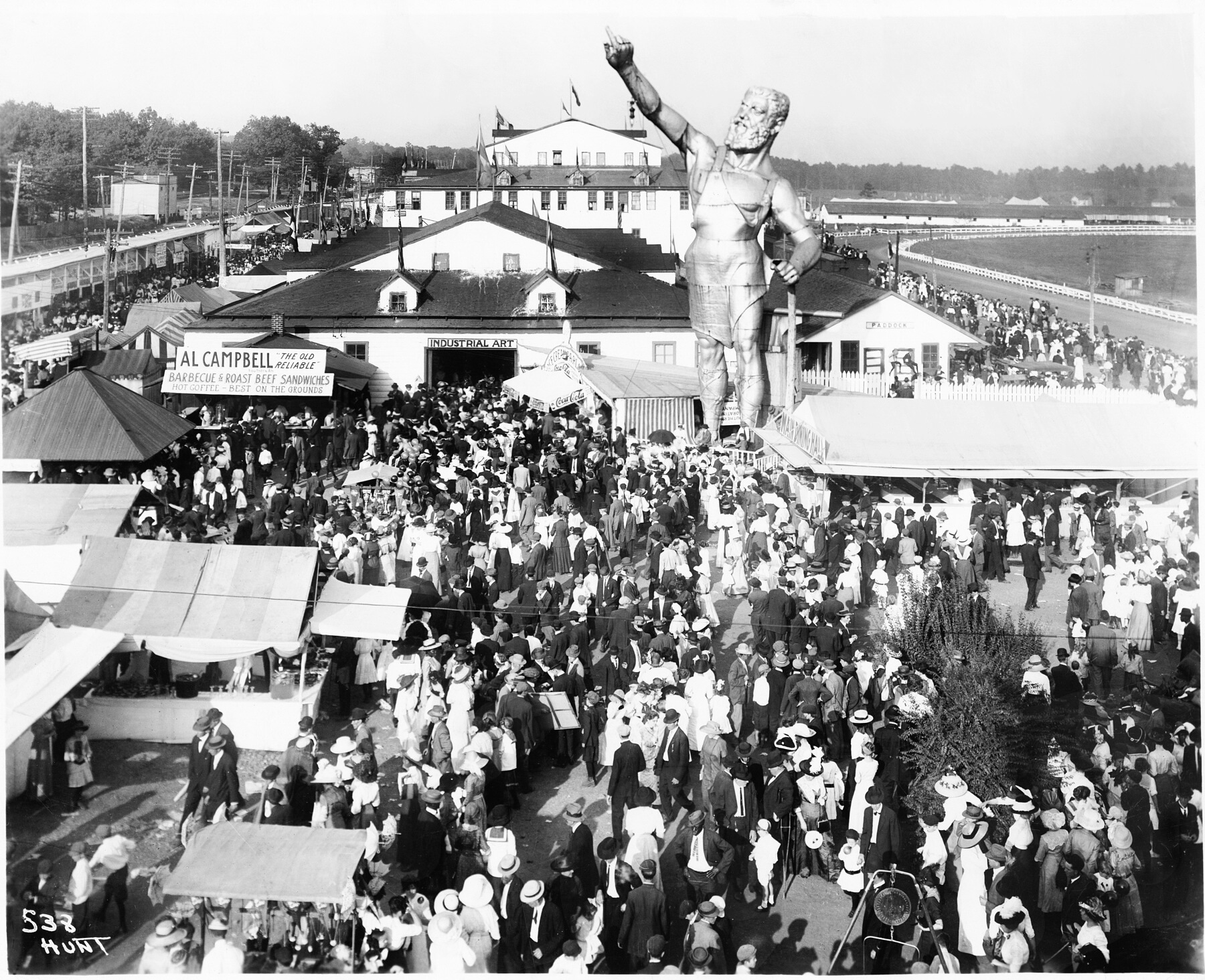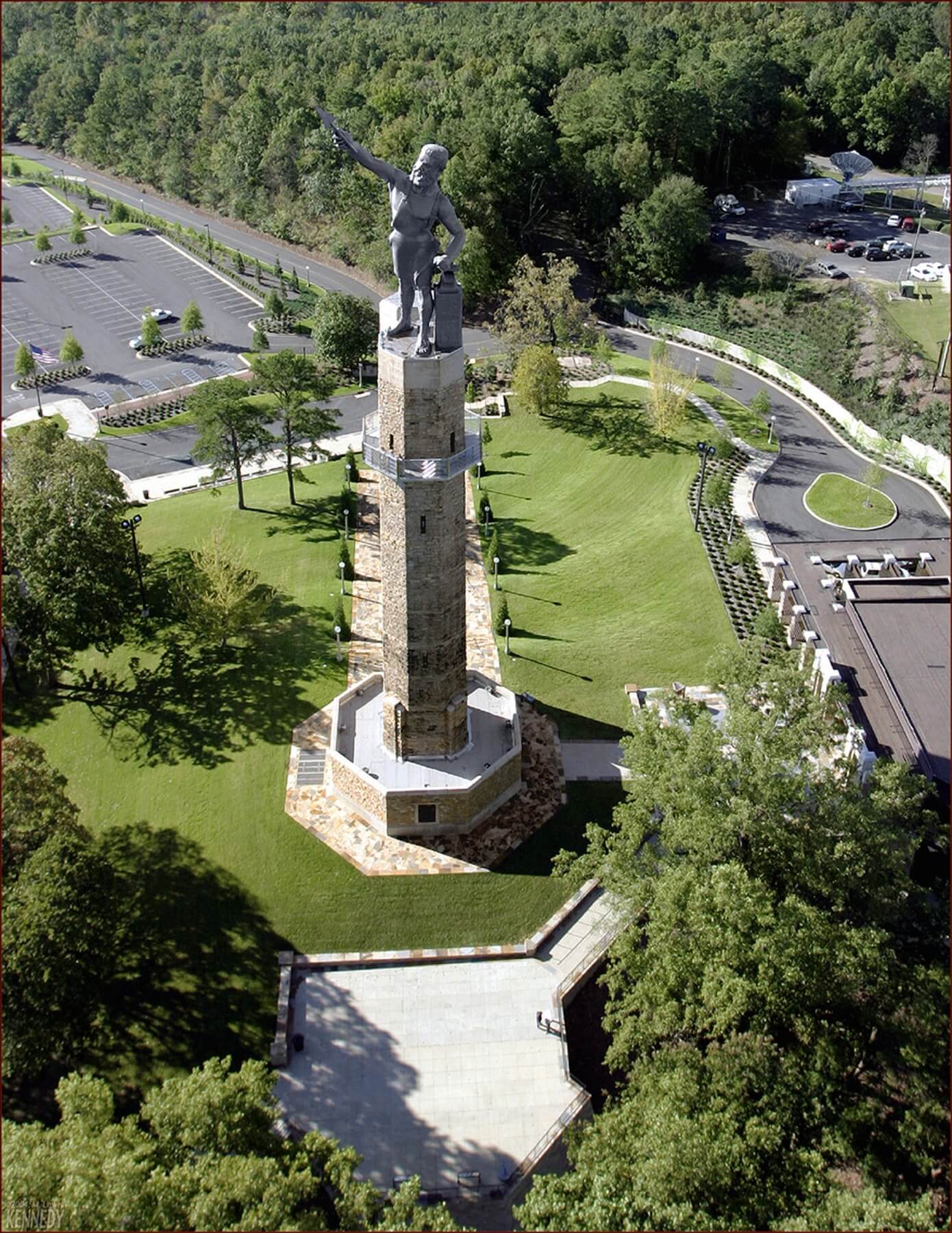Vulcan has been the symbol for the city of Birmingham since the early 1900s when Italian artist Giuseppe Moretti designed a colossal statue of the god of the forge that was then cast from local iron and shipped to St. Louis in 1904 to represent Birmingham and Alabama in the World’s Fair. Vulcan took home the grand prize and eventually made his way back to Birmingham, where he now sits atop Red Mountain, a fixture of our skyline and a reminder to natives, longtime residents and even newcomers that you are home.


But there’s so much about Vulcan that many Birmingham residents may not know. So we took a trip to the Vulcan Park & Museum and had a chat with president and CEO Darlene Negrotto and museum specialist Lindsay Elliott to uncover the hidden history of Vulcan.
Vulcan displays the magic of the Magic City.
Birmingham was founded in 1871. Because the area where the city was planted contained coal, iron ore and limestone — the raw materials needed for making iron and steel — Birmingham boomed as an industrial city and by 1900 had been dubbed the “Magic City” due to its rapid growth. City leaders wanted to advertise Birmingham by entering an exhibit in the World’s Fair in St. Louis. The Birmingham Commercial Club, a precursor of the Birmingham Regional Chamber of Commerce, decided a statue of Vulcan should be the symbol of our Magic City.
In Roman mythology, Vulcan was the god of the forge, a shop with a furnace where metal is heated and hammered into useful items. But the statue wasn’t about symbolism alone. The creation of Vulcan, which stands 56 feet tall from toe to spear point, would mean creating the largest cast iron statue in the world and the largest metal statue ever made in the United States.

“Vulcan, he was the god of the forge, and so he represented our industry,” Darlene explains, “but then creating a gigantic cast statue of Vulcan represented our technical ability to cast a quality product, which a lot of places did not have. Other places would cast things and they would just crumble.”
Vulcan needs a home.
After the World’s Fair, both St. Louis and San Francisco made offers to purchase Vulcan, Darlene says.
“San Francisco wanted to put him in the Bay to be a bookend for the Statue of Liberty,” she explains. “It really raises his stature to think of him dating the Statue of Liberty,” she adds with a laugh.
But in 1905 Vulcan was taken apart and brought back to Birmingham by train. City leaders couldn’t decide what to do with him. There was talk of placing him in Capitol Park (now known as Linn Park) but the ladies of the neighborhood objected due to Vulcan’s bare backside.

“Back then, that’s where all the prominent families and the most expensive homes were,” Darlene says. And the women didn’t deem it acceptable “to have that rear end staring at you through your parlor window,” Darlene adds.
Eventually, Vulcan was placed at the Alabama State Fairgrounds. This was meant to be a temporary home, but he stayed there for nearly 30 years! He was put together incorrectly. (For example, his left hand was turned the wrong way and thus he couldn’t hold his hammer.) And soon merchants began to use him to advertise their wares. Over the years Vulcan held a number of objects including a giant ice cream cone, a pickle sign and a Coke bottle. He once even wore a giant pair of Liberty overalls.
Plans were made to open a park especially for him atop Red Mountain, but cities across the country were struggling due to the Great Depression. With the help of the Works Progress Administration, a federal agency formed to provide more jobs, the park was opened in 1939 and our god of the forge finally had a home.



Vulcan, the god of traffic safety?
Many Birmingham natives and longtime residents can recall the days when Vulcan held not a spear but a cone-shaped lighted beacon thanks to a group of citizens who thought Vulcan should be used to remind Birminghamians to drive safely. Vulcan’s signal glowed green on days when no one was killed in an automobile accident and red on the days when there was a fatality.

Birmingham citizens save Vulcan.
Over time, the concrete that was poured inside Vulcan in the 1930s to serve as an anchor began to expand and contract causing cracks in the statue. Furthermore, since Vulcan did not have a top to his head, rain poured into the statue, too. In 1999, Vulcan had to be removed from his pedestal atop Red Mountain.
“There was not a plan for what to do with him at first,” Darlene says. “He just had to come down because he was about to crumble and fall.”
The Vulcan Park Foundation was formed to raise money for Vulcan’s restoration.
“The community really stepped up to the plate,” Darlene says. “The community rallied to save him. We were getting checks from little old ladies, and there were these school programs where they would give quarters and nickels to help save Vulcan.”
Though the City of Birmingham and the federal government contributed to the fundraising efforts, most of the $16 million that was raised to save Vulcan came from residents and local corporations.
“To me that just shows how near and dear he is to everybody’s heart,” Darlene says.
In 2003, Vulcan was placed on his pedestal once again and the following year Vulcan Park reopened, too.


Preserving the past and forging the future.
Museum specialist Lindsay Elliott wants Birmingham residents to know that a visit to Vulcan is not just a chance to get a great view of the Birmingham skyline but an opportunity to learn more about the city’s history, too.
“Not everybody knows we have a museum up here, and I think it’s exciting because we really cover Birmingham’s history,” Lindsay says. “So if anybody is new to town or still just doesn’t know a lot of Birmingham’s history, we are such a good place for helping them understand the broad view. We have so many other museums that cover sections of Birmingham’s history, but we’re really the one that does the comprehensive overview.”
The Vulcan Park & Museum recently announced a partnership with the Birmingham History Center, which has collected and preserved historical artifacts and memorabilia for over a decade. The Birmingham History Center has collected over 13,000 objects, including a knight’s armour that once stood in Blach’s department store, a J.W. Sloss money box, two carriages, scrapbooks, photographs, letters and a host of other documents. Many of these artifacts will soon be on display at the Vulcan Museum.
“We’re excited that all of these objects that are in storage will hopefully be able to come to light and become more available for research and display in our museum,” Lindsay says.



Darlene believes that Vulcan, which gave the park and museum a home, not only plays a part in preserving Birmingham’s history but also in forging the city’s future.
“When you take students from neighborhoods they’ve never left, and you bring them up here and they get to see the whole city laid out before them and understand that there’s a much bigger world out there — it really does help to solidify Vulcan and the inspiration that he stands for,” she says. “He stands for looking ahead and helping kids to be inspired to recognize that they have potential, too. It’s a real privilege what we get to do here every day.”
Vulcan Park & Museum is located at 1701 Valley View Drive, Birmingham, AL 35209.
**********
Want the best of everything local? Subscribe to StyleBlueprint!



















